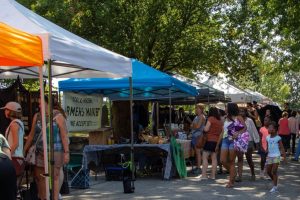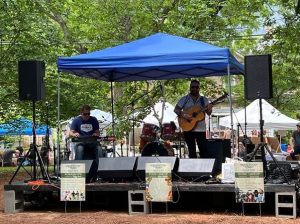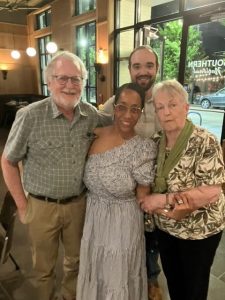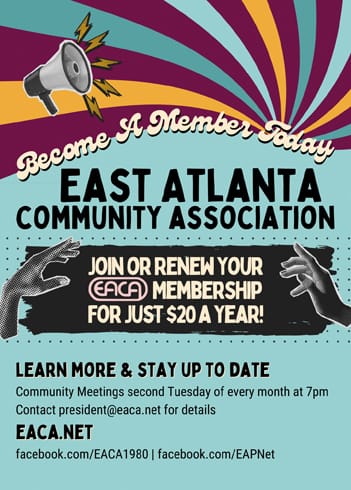By Robert Whittington Titus
Southeast Atlantans may awake on the morning of April 1, to find that their futures might be dramatically changing for the better, or not, and that’s not a joke.
March 30 is the deadline for local governments across the region to submit lists of proposed transportation projects to the State of Georgia’s Chief Transportation Planner for initial consideration for inclusion in the final Transportation Investment Act (TIA) list of projects.
For southeast Atlanta, there are several major projects that might be included on this list: segments of the Atlanta Beltline, the MARTA East I-20 mass transit initiative, and improvements to major southeast thoroughfares, local streets, and bicycle and pedestrian facilities. Voters across the state will decide whether or not these and other projects should be paid for through an additional one-cent sales tax when they vote in the 2012 referendum.
Atlanta Beltline staff, consultants, and advisors are working to refine and eventually select, with some added public input, one or more Beltline segments for inclusion in this process. These segments being considered are the southeast, northeast, southwest and northwest segments, all of which incorporate a newly introduced East-West connector, which links all proposed segments to the north-south MARTA Rail line.
The southeast route, as currently configured, but not finalized, would run from Glenwood Park, north over I-20, possibly connect with the Auburn/Edgewood Streetcar line, and continue through the Old 4th Ward to North Avenue, where the proposed route would follow North Avenue west to the North Ave MARTA Rail Station. It may include a spur past that point to connect tens of thousands of additional potential users at Georgia Tech, Coca-Cola, and the Centennial Place housing complex.
Notably absent from this proposed southeast segment is a continuation of service south of Glenwood Park to neighborhoods like Ormewood Park, Grant Park, Chosewood Park, the Beltline’s own Boulevard Crossing Park, and the provision of rail service for the estimated two million people that visit Grant Park, Zoo Atlanta, and the Cyclorama annually.
Beltline staff indicate that the relatively light use of the CSX rail line to serve the Lafarge cement plant on Glenwood Avenue represents regulatory, legal, and financial hurdles substantial enough to exclude that section for consideration within the TIA process; however, a portion of the Lafarge property is currently for sale, so this situation could change in the near future. Some fact finding and discussion regarding this situation is ongoing and Neighborhood Planning Unit-W has requested that the Beltline provide documentation of these matters on or before March 21st.
Members of NPU-W, South Atlantans for Neighborhood Development, and Grant Park Neighborhood Association remain generally supportive and enthusiastic about the Atlanta Beltline and the many different and interrelated components of the project that promise to provide significant improvements for the area and a framework for related development activities. But NPU-W, SAND, and GPNA all voted to defer approval of the land use and related zoning changes proposed for the sub-area 4 section of the Beltline, which includes ‘focus areas’ around Glenwood Park, Memorial Drive/Bill Kennedy Way, Memorial Drive/Moreland Avenue, and the area around the Reynoldstown MARTA Rail station.
These sub-area 4 groups agreed that there were meaningful transportation infrastructure and public safety concerns that were not being adequately addressed by the proposed plan. Complex issues that remained unresolved at the time that the community was asked to approve the Beltline sub-area 4 plan in December of 2010 included a major redesign of the traffic functions of Memorial, the specific route(s) of the three alternative transit (rail) components, proposed pedestrian and bike routes and facilities (or lack thereof) and absence of meaningful consideration of related increased public safety services. Major projects and improvements to the Moreland corridor envisioned within the South Moreland and North Moreland Livable Community Initiatives (as approved by the City and adopted by the Atlanta Regional Commission) were not addressed or included within the Beltline sub-area 4 plan. Residents engaged in the process agreed that they could not reasonably approve a plan with so many loose ends.
Beltline and City personnel have indicated they are working to address most of the issues of concern to NPU-W, SAND, and GPNA. The inclusion of the southeast segment of the Beltline in the Transportation Investment Act list of projects would effectively address many of the transportation related concerns expressed by these groups. Many in the community strongly support such a solution.
One other major Beltline-related transportation issue of note that remains unresolved involves its physical and operational interaction with the MARTA East I-20 Mass Transit Initiative. The MARTA East I-20 planning process now underway is an attempt to update a five-year-old plan to address the lack of mass transit services in the southeast Atlanta/I-20/South DeKalb areas. Five years ago, the basic plan elements included a proposed Bus Rapid Transit (BRT) system linking downtown Atlanta with points east in DeKalb County. It included proposed stations at Turner Field, and the Interstate 20 Interchanges at Moreland Avenue, Glenwood Avenue, Gresham Road, Candler Road, and several other points outside the I-285 perimeter, reaching almost to the DeKalb County/Rockdale County line. Now, the major change in the plan seems to involve a commitment to move forward with a rail based transit option and stations located at Glenwood Park and possibly near East Atlanta Village.
As a result, a very important opportunity exists for southeast Atlanta where this major new transportation resource would intersect with the Beltline rail system at Glenwood Park and/or possibly in East Atlanta.
If thought of as one combined transportation facility, the intersection of the north-south Beltline service with the east-west service of the MARTA East I-20 line at Glenwood Park could, by providing extremely modern, scalable, efficient and extremely high capacity modern transportation services, conceivably catapult the immediate area into a model regional employment and housing center. This initiative could reflect the most current and contemporary urban design philosophies and values, drawn from a world class group of talented professionals and committed citizenry, which itself reflects an amazingly diverse and skilled group of individuals and families.
And there’s possibly more good news for the Moreland Avenue corridor. Working primarily within the context of the South Moreland LCI initiative, which is being shepherded by SouthStar, initial planning work has been completed on the realignment of the Moreland/Glenwood intersection. Funding to continue to the next stage of this project must be identified within the current budget cycles of the city. Some of the bike and pedestrian concepts envisioned within that initiative, as well as some bike and pedestrian elements of the Beltline sub-area 4 plans, may also find their way into the list of TIA projects to be presented to the state this month. This could include some truly important improvements for the rapidly growing group of bicyclists in southeast Atlanta, who use the most energy efficient form of human transport on a daily basis, including vastly improved north-south routes crossing I-20 and Memorial Drive.
It seems that there is reason to hope that southeast Atlanta may be experiencing one of those few once in a lifetime moments. If all goes well, the resulting long-term benefits of these combined projects will fuel the next round of cultural, socioeconomic and physical growth that has transformed much of the area over the last two or three decades.
If all of this sounds like a good path to follow, you can help. In fact, you are essential. Become further educated on the issues and opportunities. Contact your local and state elected officials now. Engage in the planning processes that are still taking place. Get involved in your neighborhood organizations and NPU-W. The NPU-W Transportation Committee usually meets at 6:30pm on the 4th Wednesday of each month and the full NPU-W meeting follows at 7:30pm at Martha Brown United Methodist Church (at the corner of Metropolitan Avenue and Moreland Avenue, auto and bike parking in the rear). If you’re walking to the meeting, please be careful along Moreland.
To learn more about the planning initiatives and projects mentioned in this article, please send your questions to info@southstarcdc.org. You can also check out www.atlantaga.gov and www.beltline.org.
Elizabeth Dillon and Ron Lall contributed to this article.








Be First to Comment